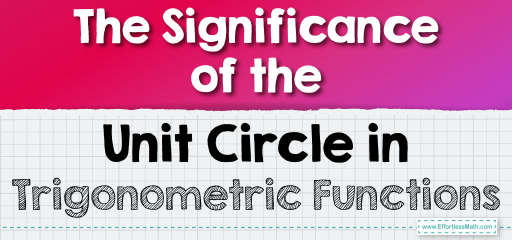The Significance of the Unit Circle in Trigonometric Functions

Significance of Quadrants in Trigonometry
- All functions are positive
- Sine and cosecant are positive
- Tangent and cotangent are positive
- Cosine and secant are positive.
Coordinates on the Unit Circle
Any angle, corresponds to a specific point on the circumference of the unit circle. The x-coordiante of that point is the cosine value of that angle, and the y-coordinate is the sine value.
For example, at \(30^\circ\) or \(\frac{\pi}{6}\) radians, the point on the unit circle has the x-coordinate of \(\frac{\sqrt{3}}{2}\), which is cosine of \(30^\circ\), and a y-coordinate of \(\frac{1}{2}\), which is sine of \(30^\circ\). Similarly, for \(45^\circ\) or \(\frac{\pi}{6}\) radians, sine and cosine are equal \(\frac{\sqrt{2}}{2}\)
Extending to Other Trigonometric Functions
Now that we know how to find the values for sine and cosine of an angle, we can use them to find the values for other trigonometric functions. \(\frac{\sin x}{\cos x} = \tan x\), and the inverse of tangent, is cotangent.
Secant is the inverse of cosine \((\frac{1}{\cos x})\) and cosecant is the inverse of sine \((\frac{1}{\sin x})\)
For example, for the \(\frac{\pi}{4}\) angle, we have:
\(\tan \left(\frac{\pi}{4}\right) = \frac{\sin \left(\frac{\pi}{4}\right)}{\cos \left(\frac{\pi}{4}\right)} = \frac{\sqrt{2}/2}{\sqrt{2}/2} = 1 = \cot \left(\frac{\pi}{4}\right)\)
\(\sec \left(\frac{\pi}{4}\right) = \frac{1}{\cos \left(\frac{\pi}{4}\right)} = \frac{1}{\frac{\sqrt{2}}{2}} = \sqrt{2}\)
Symmetry in Trigonometric Functions
- An even function is symmetric around the y-axis, meaning \(f(x)=f(-x)\), for all \(x\).
- An odd function is symmetric with respect to the origin, satisfying \(f(x)=-f(-x)\), for all \(x\).
For example, \(\sin x\) is odd, while \(\cos x\) is even. This can be helpful when we want to convert trigonometric functions to each other. For example, \(\sin 120^\circ = +0.86\), while \(\sin (-120^\circ) = -0.86\). and from unit circle, we know that \(-120^\circ = 240^\circ\), since \(0\) and \(360\) are basically in the same place, so: \(360^\circ – 120^\circ = 240^\circ\)
\(\begin{align*} \sin^2 \left(\frac{\pi}{4}\right) + \cos^2 \left(\frac{\pi}{4}\right) &= \left( \frac{\sqrt{2}}{2} \right)^2 + \left( \frac{\sqrt{2}}{2} \right)^2 \\&= \frac{2}{4} + \frac{2}{4} \\&= \frac{1}{2} + \frac{1}{2} \\&= 1\end{align*}\)
Trigonometric Identities and the Unit Circle
There are various trigonometric identities that help to convert angles of trigonometric functions to other angles, trigonometric functions to one another, eliminate/create exponents, and so on.
These identities can mix up with each other to generate new identities. Some of them are used frequently in trigonometry, while others not as often. For instance, the identity \(\sin^2 x + \cos^2 x = 1\)
Is used very often, and many other useful identities are derived from it. Let’s test it for \(45^\circ\):
Here are a list of useful trigonometric identities:
\(\sin 2\theta = 2 \sin \theta \cos \theta\)
\(\cos 2\theta = 1 – 2\sin^2 \theta = 2\cos^2 \theta – 1 = \cos^2 \theta – \sin^2 \theta = \frac{\cot^2 \theta – 1}{2\cot \theta}\)
\(\tan 2\theta = \frac{2 \tan \theta}{1 – \tan^2 \theta}\)
\(\cos^2 \theta = \frac{1 + \cos 2\theta}{2}\)
\(\sin^2 \theta = \frac{1 – \cos 2\theta}{2}\)
\(\sin(a + b) = \sin a \cdot \cos b + \sin b \cdot \cos a\)
\(\sin(a – b) = \sin a \cdot \cos b – \sin b \cdot \cos a\)
\(\cos(a + b) = \cos a \cdot \cos b – \sin a \cdot \sin b\)
\(\cos(a – b) = \cos a \cdot \cos b + \sin a \cdot \sin b\)
\(\tan(a + b) = \frac{\tan a + \tan b}{1 – \tan a \cdot \tan b}\)
\(\tan(a – b) = \frac{\tan a – \tan b}{1 + \tan a \cdot \tan b}\)
\(\cot(a + b) = \frac{\cot a \cdot \cot b – 1}{\cot b + \cot a}\)
\(\cot(a – b) = \frac{\cot a \cdot \cot b + 1}{\cot b – \cot a}\)
\(\sin a + \sin b = 2 \sin \left(\frac{a + b}{2}\right) \cdot \cos \left(\frac{a – b}{2}\right)\)
\(\sin a – \sin b = 2 \cos \left(\frac{a + b}{2}\right) \cdot \sin \left(\frac{a – b}{2}\right)\)
\(\cos a + \cos b = 2 \cos \left(\frac{a + b}{2}\right) \cdot \cos \left(\frac{a – b}{2}\right)\)
\(\cos a – \cos b = -2 \sin \left(\frac{a + b}{2}\right) \cdot \sin \left(\frac{a – b}{2}\right)\)
\(\tan x + \tan y = \frac{\sin(x + y)}{\cos x \cdot \cos y}\)
\(\tan x – \tan y = \frac{\sin(x – y)}{\cos x \cdot \cos y}\)
\(\cot x + \cot y = \frac{\sin(x + y)}{\sin x \cdot \sin y}\)
\(\cot x – \cot y = \frac{\sin(y – x)}{\sin x \cdot \sin y}\)
\(\sin a \cdot \cos b = \frac{1}{2}[\sin(a + b) + \sin(a – b)]\)
\(\cos a \cdot \cos b = \frac{1}{2}[\cos(a + b) + \cos(a – b)]\)
\(\sin a \cdot \sin b = -\frac{1}{2}[\cos(a + b) – \cos(a – b)]\)
\(\sin 3a = -4 \sin^3 a + 3 \sin a\)
\(\cos 3a = 4 \cos^3 a – 3 \cos a\)
Related to This Article
More math articles
- How to Solve and Graph One-Step Inequalities with Rational Numbers?
- CBEST Math-Test Day Tips
- How to Prepare for the HSPT Math Test?
- The Ultimate 6th Grade WVGSA Math Course (+FREE Worksheets)
- How to Find Modulus (Absolute Value) and Argument (Angle) of Complex Numbers?
- How to Find Complementary, Supplementary, Vertical, Adjacent, and Congruent Angles?
- Convert Units of Measurement
- Top 10 Tips You MUST Know to Retake the TASC Math
- Top 10 Tips You MUST Know to Retake the SAT Math
- 3rd Grade NDSA Math Worksheets: FREE & Printable




























What people say about "The Significance of the Unit Circle in Trigonometric Functions - Effortless Math: We Help Students Learn to LOVE Mathematics"?
No one replied yet.